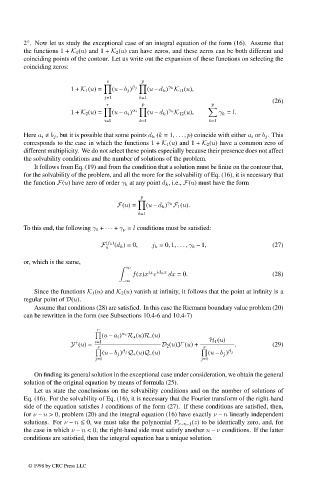Page 573 - Handbook Of Integral Equations
P. 573
◦
2 . Now let us study the exceptional case of an integral equation of the form (16). Assume that
the functions 1 + K 1 (u) and 1 + K 2 (u) can have zeros, and these zeros can be both different and
coinciding points of the contour. Let us write out the expansion of these functions on selecting the
coinciding zeros:
s p
1+ K 1 (u)= (u – b j ) β j (u – d k ) K 11 (u),
γ k
j=1 k=1
(26)
r p p
1+ K 2 (u)= (u – a i ) α i (u – d k ) K 12 (u), γ k = l.
γ k
i=1 k=1 k=1
Here a i ≠ b j , but it is possible that some points d k (k =1, ... , p) coincide with either a i or b j . This
corresponds to the case in which the functions 1 + K 1 (u) and 1 + K 2 (u) have a common zero of
different multiplicity. We do not select these points especially because their presence does not affect
the solvability conditions and the number of solutions of the problem.
It follows from Eq. (19) and from the condition that a solution must be finite on the contour that,
for the solvability of the problem, and all the more for the solvability of Eq. (16), it is necessary that
the function F(u) have zero of order γ k at any point d k , i.e., F(u) must have the form
p
F(u)= (u – d k ) F 1 (u).
γ k
k=1
To this end, the following γ 1 + ··· + γ p = l conditions must be satisfied:
(j k )
F u (d k )=0, j k =0, 1, ... , γ k – 1, (27)
or, which is the same,
∞
j k id k x
f(x)x e dx = 0. (28)
–∞
Since the functions K 1 (u) and K 2 (u) vanish at infinity, it follows that the point at infinity is a
regular point of D(u).
Assume that conditions (28) are satisfied. In this case the Riemann boundary value problem (20)
can be rewritten in the form (see Subsections 10.4-6 and 10.4-7)
r
(u – a i ) R + (u)R – (u)
α i
+
–
Y (u)= i=1 D 2 (u)Y (u)+ H 1 (u) . (29)
s
(u – b j ) Q + (u)Q – (u) s (u – b j ) β j
β j
j=1 j=1
On finding its general solution in the exceptional case under consideration, we obtain the general
solution of the original equation by means of formula (25).
Let us state the conclusions on the solvability conditions and on the number of solutions of
Eq. (16). For the solvability of Eq. (16), it is necessary that the Fourier transform of the right-hand
side of the equation satisfies l conditions of the form (27). If these conditions are satisfied, then,
for ν – n > 0, problem (20) and the integral equation (16) have exactly ν – n linearly independent
solutions. For ν – n ≤ 0, we must take the polynomial P ν–n–1 (z) to be identically zero, and, for
the case in which ν – n < 0, the right-hand side must satisfy another n – ν conditions. If the latter
conditions are satisfied, then the integral equation has a unique solution.
© 1998 by CRC Press LLC
© 1998 by CRC Press LLC
Page 556

